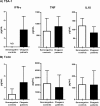Trypanosoma cruzi vaccine candidate antigens Tc24 and TSA-1 recall memory immune response associated with HLA-A and -B supertypes in Chagasic chronic patients from Mexico
- PMID: 29377898
- PMCID: PMC5805372
- DOI: 10.1371/journal.pntd.0006240
Trypanosoma cruzi vaccine candidate antigens Tc24 and TSA-1 recall memory immune response associated with HLA-A and -B supertypes in Chagasic chronic patients from Mexico
Abstract
Trypanosoma cruzi antigens TSA-1 and Tc24 have shown promise as vaccine candidates in animal studies. We evaluated here the recall immune response these antigens induce in Chagasic patients, as a first step to test their immunogenicity in humans. We evaluated the in vitro cellular immune response after stimulation with recombinant TSA-1 (rTSA-1) or recombinant Tc24 (rTc24) in mononuclear cells of asymptomatic Chagasic chronic patients (n = 20) compared to healthy volunteers (n = 19) from Yucatan, Mexico. Proliferation assays, intracellular cytokine staining, cytometric bead arrays, and memory T cell immunophenotyping were performed by flow cytometry. Peripheral blood mononuclear cells (PBMC) from Chagasic patients showed significant proliferation after stimulation with rTc24 and presented a phenotype of T effector memory cells (CD45RA-CCR7-). These cells also produced IFN-γ and, to a lesser extent IL10, after stimulation with rTSA-1 and rTc24 proteins. Overall, both antigens recalled a broad immune response in some Chagasic patients, confirming that their immune system had been primed against these antigens during natural infection. Analysis of HLA-A and HLA-B allele diversity by PCR-sequencing indicated that HLA-A03 and HLA-B07 were the most frequent supertypes in this Mexican population. Also, there was a significant difference in the frequency of HLA-A01 and HLA-A02 supertypes between Chagasic patients and controls, while the other alleles were evenly distributed. Some aspects of the immune response, such as antigen-induced IFN-γ production by CD4+ and CD8+ T cells and CD8+ proliferation, showed significant association with specific HLA-A supertypes, depending on the antigen considered. In conclusion, our results confirm the ability of both TSA-1 and Tc24 recombinant proteins to recall an immune response induced by the native antigens during natural infection in at least some patients. Our data support the further development of these antigens as therapeutic vaccine against Chagas disease.
Conflict of interest statement
The authors have declared that no competing interests exist.
Figures







Similar articles
-
Expression, purification, immunogenicity, and protective efficacy of a recombinant Tc24 antigen as a vaccine against Trypanosoma cruzi infection in mice.Vaccine. 2015 Aug 26;33(36):4505-12. doi: 10.1016/j.vaccine.2015.07.017. Epub 2015 Jul 17. Vaccine. 2015. PMID: 26192358
-
HLA Class I-T cell epitopes from trans-sialidase proteins reveal functionally distinct subsets of CD8+ T cells in chronic Chagas disease.PLoS Negl Trop Dis. 2008;2(9):e288. doi: 10.1371/journal.pntd.0000288. Epub 2008 Sep 3. PLoS Negl Trop Dis. 2008. PMID: 18846233 Free PMC article.
-
Promiscuous Recognition of a Trypanosoma cruzi CD8+ T Cell Epitope among HLA-A2, HLA-A24 and HLA-A1 Supertypes in Chagasic Patients.PLoS One. 2016 Mar 14;11(3):e0150996. doi: 10.1371/journal.pone.0150996. eCollection 2016. PLoS One. 2016. PMID: 26974162 Free PMC article. Clinical Trial.
-
Vaccine development against Trypanosoma cruzi and Chagas disease.Adv Parasitol. 2011;75:121-46. doi: 10.1016/B978-0-12-385863-4.00006-X. Adv Parasitol. 2011. PMID: 21820554 Review.
-
Accelerating the development of a therapeutic vaccine for human Chagas disease: rationale and prospects.Expert Rev Vaccines. 2012 Sep;11(9):1043-55. doi: 10.1586/erv.12.85. Expert Rev Vaccines. 2012. PMID: 23151163 Free PMC article. Review.
Cited by
-
Extent of polymorphism and selection pressure on the Trypanosoma cruzi vaccine candidate antigen Tc24.Evol Appl. 2020 Sep 10;13(10):2663-2672. doi: 10.1111/eva.13068. eCollection 2020 Dec. Evol Appl. 2020. PMID: 33294015 Free PMC article.
-
A prophylactic α-Gal-based glycovaccine effectively protects against murine acute Chagas disease.NPJ Vaccines. 2019 Mar 22;4:13. doi: 10.1038/s41541-019-0107-7. eCollection 2019. NPJ Vaccines. 2019. PMID: 30911415 Free PMC article.
-
α-Gal immunization positively impacts Trypanosoma cruzi colonization of heart tissue in a mouse model.PLoS Negl Trop Dis. 2021 Jul 27;15(7):e0009613. doi: 10.1371/journal.pntd.0009613. eCollection 2021 Jul. PLoS Negl Trop Dis. 2021. PMID: 34314435 Free PMC article.
-
Vaccine-linked chemotherapy induces IL-17 production and reduces cardiac pathology during acute Trypanosoma cruzi infection.Sci Rep. 2021 Feb 5;11(1):3222. doi: 10.1038/s41598-021-82930-w. Sci Rep. 2021. PMID: 33547365 Free PMC article.
-
Evaluation of the immune response against Trypanosoma cruzi cytosolic tryparedoxin peroxidase in human natural infection.Immunology. 2018 Nov;155(3):367-378. doi: 10.1111/imm.12979. Epub 2018 Aug 3. Immunology. 2018. PMID: 29972690 Free PMC article. Clinical Trial.
References
-
- Rassi A Jr., Rassi A, Marin-Neto JA (2010) Chagas disease. Lancet 375: 1388–1402. doi: 10.1016/S0140-6736(10)60061-X - DOI - PubMed
-
- Perez-Molina JA, Molina I (2017) Chagas disease. Lancet. - PubMed
-
- Gunter SM, Murray KO, Gorchakov R, Beddard R, Rossmann SN, et al. (2017) Likely Autochthonous Transmission of Trypanosoma cruzi to Humans, South Central Texas, USA. Emerg Infect Dis 23: 500–503. doi: 10.3201/eid2303.161157 - DOI - PMC - PubMed
-
- Beaumier CM, Gillespie PM, Strych U, Hayward T, Hotez PJ, et al. (2016) Status of vaccine research and development of vaccines for Chagas disease. Vaccine 34: 2996–3000. doi: 10.1016/j.vaccine.2016.03.074 - DOI - PubMed
-
- Antinori S, Galimberti L, Bianco R, Grande R, Galli M, et al. (2017) Chagas disease in Europe: A review for the internist in the globalized world. Eur J Intern Med. - PubMed
Publication types
MeSH terms
Substances
Grants and funding
LinkOut - more resources
Full Text Sources
Other Literature Sources
Medical
Research Materials

